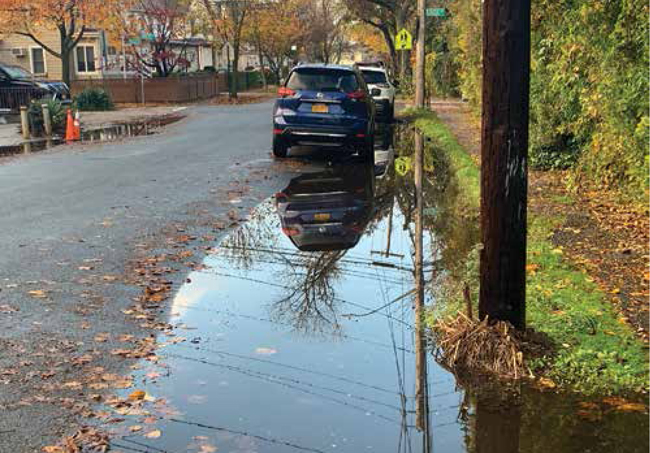
Even mild rain days result in significant flooding on Island streets and roadways in Pelham Bay Park. Credit: Community Flood Watch Project.
— Published by John Doyle for December 2020 The Island Current e-newsletter
New York, NY, December 1, 2020 - As the hurricane season reaches its conclusion at the end of November, City Islanders have, thankfully, been spared a large-scale natural disaster. However, even mild rain days result in significant flooding on Island streets and roadways in Pelham Bay Park (photos above). In an effort to address these issues, City Island Rising is partnering with the New York Sea Grant Program to document flooding and how it is affecting our community.
New York Sea Grant is a 50-year-old statewide network of integrated research, education and extension services that promote the economic vitality of coastal communities, environmental sustainability and citizen awareness about the state’s marine resources. In New York City, the organization has established a Science and Resilience Institute at Jamaica Bay, partnering with the City University of New York and other educational institutions to provide scientific research and perspective on vital environmental issues that impact communities every day.
Since December 2019, New York Sea Grant staff have visited City Island on several occasions to meet with Rising members, the NYC Office of Emergency Management (OEM) and the district manager of Community Board 10, Matt Cruz, in an effort to gain data about flooding on City Island, whether caused by high tides, rain storms or inadequate drainage. Some of these areas are well known to residents—the west end of Ditmars Street, Minneford Avenue and Cross Street, the road leading to Orchard Beach—whereas some locations are less noticeable. By documenting each location, residents are providing scientific evidence in order to prove how City Island’s resiliency needs are being neglected on all levels of government, leaving the community vulnerable to future storms. In less than 11 months, more than 550 area photos have been submitted to New York Sea Grant.

Even mild rain days result in significant flooding on Island streets and roadways in Pelham Bay Park. Credit: Community Flood Watch Project.
Islander David Diaz, a board member of Rising, hopes that this evidence will provide a convincing argument to local officials and policy makers that the Island’s flooding issues can no longer be ignored. “In the world of public policy, whoever has the evidence usually wins the argument,” Mr. Diaz explained. “We are trying to help Islanders make our own argument that resiliency measures are needed and to do so in a way that is both compelling and understood by those in power.”
Residents are encouraged to submit their own photos through New York Sea Grant “Community Flood Watch Project Survey” website or by contacting City-IslandRising@gmail.com. Residents are also encouraged to report flooding to the City of New York via 311 and to send compliant reference numbers to Rising.
Katie Graziano, a Coastal Resilience Extension Specialist with the New York Sea Grant, told The Current, “the Community Flood Watch Project depends on strong partnerships like the one we have with City Island Rising. The residents of City Island have invaluable local knowledge of flood locations, timing, and impacts.”
More Info: New York Sea Grant and SRIatJB
The Science and Resilience Institute @ Jamaica Bay
(SRIJB) is a research center focused on enhancing environmental,
social, and economic resilience in communities of Jamaica Bay funded by
the Rockefeller Foundation and the City of New York.
New York Sea Grant (NYSG), a cooperative program of Cornell University
and the State University of New York (SUNY), is one of 34 university-based
programs under the National Oceanic and Atmospheric Administration’s
National Sea Grant College Program.
Since 1971, NYSG has represented a statewide network of integrated
research, education and extension services promoting coastal community
economic vitality, environmental sustainability and citizen awareness
and understanding about the State’s marine and Great Lakes resources.
Through NYSG’s efforts, the combined talents of university scientists
and extension specialists help develop and transfer science-based
information to many coastal user groups—businesses and industries,
federal, state and local government decision-makers and agency managers,
educators, the media and the interested public.
The program maintains Great Lakes offices at Cornell University, University at Buffalo, SUNY Oswego and the Wayne County Cooperative Extension office
in Newark. In the State's marine waters, NYSG has offices at Stony Brook
University in Long Island, Brooklyn College and Cornell Cooperative
Extension in NYC and Kingston in the Hudson Valley.
For updates on Sea Grant activities: www.nyseagrant.org has RSS, Facebook, Twitter, Instagram, and YouTube links. NYSG offers a free e-list sign up via www.nyseagrant.org/nycoastlines for its flagship publication, NY Coastlines/Currents, which is published quarterly. Our program also produces an occasional e-newsletter,"NOAA Sea Grant's Social Media Review," via its blog, www.nyseagrant.org/blog.